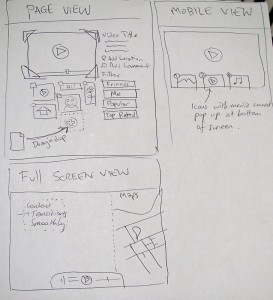This is the first in what will be a series of blog posts for the Mozilla-Knight Journalism Challenge. This week we heard from Aza Raskin, former creative lead for Firefox and head of user experience for Mozilla, talking about the power of prototyping for understanding problems and building momentum behind your solution.
As a programmer I often build throw-away apps in my spare time just to see how something works, explore a new API, or to discover new ways of solving old problems. However, in my professional life as a web developer, it’s easy to see building prototypes as a luxury. I’ve often had to fight for a budget that allows for scoping and prototyping, and even more often had to go without.
Raskin’s presentation, “How to Prototype and Influence People“, explores the advantages of prototyping in ways that I hadn’t previously recognised. These insights can be grouped into two main areas:
1. Developing a better understanding of the problem
Trying several ways to solve a problem leads to a better solution, but can also lead to the recognition of a deeper problem on which the solution is dependent. Raskin used the tale of Paul MacReady‘s winning of the Kremer Prize for long-distance human-powered flight as an example of this; MacReady’s key insight was that by dramatically reducing the time to repair and modify his aircraft, he could arrive at a winning design in a matter of months instead of decades. He was right. Failing fast through prototyping led to rapid learning, which led to rapid improvement.
2. Building support for your idea or product
Many entrepreneurs toil for years on products that are technically interesting without ever testing the interface on a live end-user. To an end-user a product is not an idea, nor a technology. To your customers, the product is the interface.By encouraging end-users to experience some aspect of a product’s interface you can observe their reaction to it and learn how to communicate the benefits more effectively. Putting the prototype in the hands of end-users keeps you focused on solving real-world problems.
As Aza put it:Â The value of an idea is zero unless it can be communicated.
Aza’s approach to prototyping is fast and pragmatic. He encourages creating the first prototype in a day. You’re should be creating a “visual sketch”, a space people can move through with their ideas. This allows them to see the solution for themselves, which is always more convincing than being told how great an idea is, or being dictated to by an over-wrought solution. Palm’s Jeff Hawkins first prototyped their hand-held devices using blocks of wood – as lo-fi as it gets.
Aza began and ended the presentation with a quote from Margaret Mead:
Never doubt that a small group of committed people can change the world. Indeed, it’s the only thing that ever has.
If you’re a small team looking to change the world, then recognising the power of rapid prototyping could give your idea a big boost.


Hi Dan.
One of the things Aza said in his talk is that our first ideas will likely be tossed. You hinted at this when you said you often build throw-away apps. So how do we know when our idea sucks if we are so attached to it? I guess how do you measure failure (aside from money)?
Amy
Hi Amy,
I think you have to create (and evolve) measures of success that are related to your goals.
So, for example, Aza works in the health field, and he might measure aggregate health outcomes in order to test the effectiveness of his product.
Or he may choose the simpler route and measure adoption, usage patterns over time, and so on.
Basically, once a product is launched, your idea sucks if (a) noone uses it, and (b) it doesn’t create the desired outcome.
But how do you assess a prototype? I would argue that it’s largely along the same lines, though with a smaller userbase. Are people excited about picking up the prototype again? Are they full of ideas? Do they naturally gravitate towards an appreciation of the product that mirrors its intent?
If so, you’re on a winner and should continue.